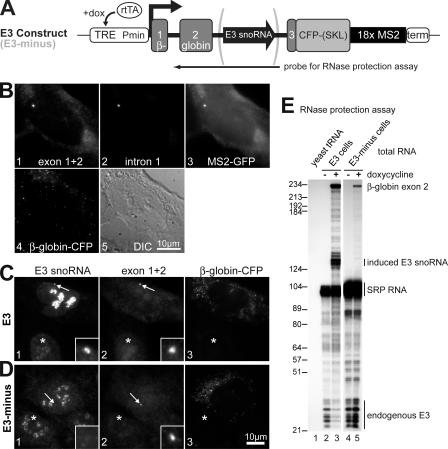Figure 3.
Stable human U2OS cell lines expressing rat H/ACA RNA E3 from an inducible promoter. (A) Schematic of the construct that was stably integrated into the genome of the E3 and E3-minus cell lines. Expression was driven by a minimal CMV promoter (Pmin) under the control of the tetracycline response element (TRE) and was induced in the presence of doxycycline (dox) by the transactivator rtTA. The construct contained the polyadenylation/cleavage signal and transcriptional terminator (term) of the bovine growth hormone. The size of the probe used in the RNase protection assay (E) is indicated underneath. (B) Fluorescent micrographs of an E3 cell induced for transgene expression and assayed by FISH with Cy3-labeled probes to exon 1 and 2 (panel 1) and a Cy5-labeled probe to intron 1 (panel 2) and by direct fluorescence for MS2-GFP (panel 3) and for β-globin–CFP (panel 4). Panel 5 depicts the corresponding differential interference contrast image of the cell. (C and D) Triple fluorescence by FISH with probes to the induced rat E3 snoRNA (panel 1), which cross-hybridizes with the endogenous human E3 in uninduced cells (asterisks), and to exon 1 and 2 for identification of the transcription sites (panel 2), and by direct fluorescence of β-globin–CFP in peroxisomes (panel 3) to differentiate the induced cells from the uninduced cells. Insets (width = 2.6 μm) show a magnification of the transcription sites (arrows). (E) RNase protection assay. Autoradiograph of the sequencing gel used to separate the fragments protected from digestion by RNase A and T1. Yeast tRNA (lane 1) and total RNA from E3 (lanes 2 and 3) or E3-minus cells (lanes 4 and 5) isolated before (lanes 2 and 4) or 24 h after (lanes 3 and 5) induction with doxycycline were hybridized to the radiolabeled probe indicated in A. In addition, a separate probe corresponding to 100 nucleotides of SRP RNA was included in all samples as a control. The migrating positions of the protected fragments are indicated on the right. Note that because the probe corresponded to the rat E3 snoRNA of the integrated constructs, it protected only the smaller fragments of the endogenous human E3 snoRNA, which differed in 13 nucleotides from that of the rat.

